North was the name of the game onboard Sea Rose, as we eagerly headed out from Kalmar to discover Sweden’s skargard (“sharr-gourd”). Loosely translated skargard means archipelago, but most Swedes would be a bit disappointed in this meek description. Breaking down this compound word, ‘skar’ refers to a rocky outcrop, and ‘gard’ has several meanings, the most enticing to me is garden. So we have ourselves a ‘rock garden’. The populated centers of Gothenburg on the west coast and Stockholm on the east coast are literally chock full of rock gardens. In the waters near Stockholm, a staggering 24,000 islands comprise the largest skargard in Sweden and these draw summer holiday-makers out to a reported 50,000 cottages. The density of islands is mind-boggling and caused Karen and I to feel at once both titillated and intimidated. Would we be able to safely navigate these congested waterways? Would shifting winds above and submerged rock pinnacles below find their mark on a track record that we had so far kept clean? A little warmup would help allay our concerns, and we found it this week as we wound in and out of the smaller archipelagos south of Stockholm.

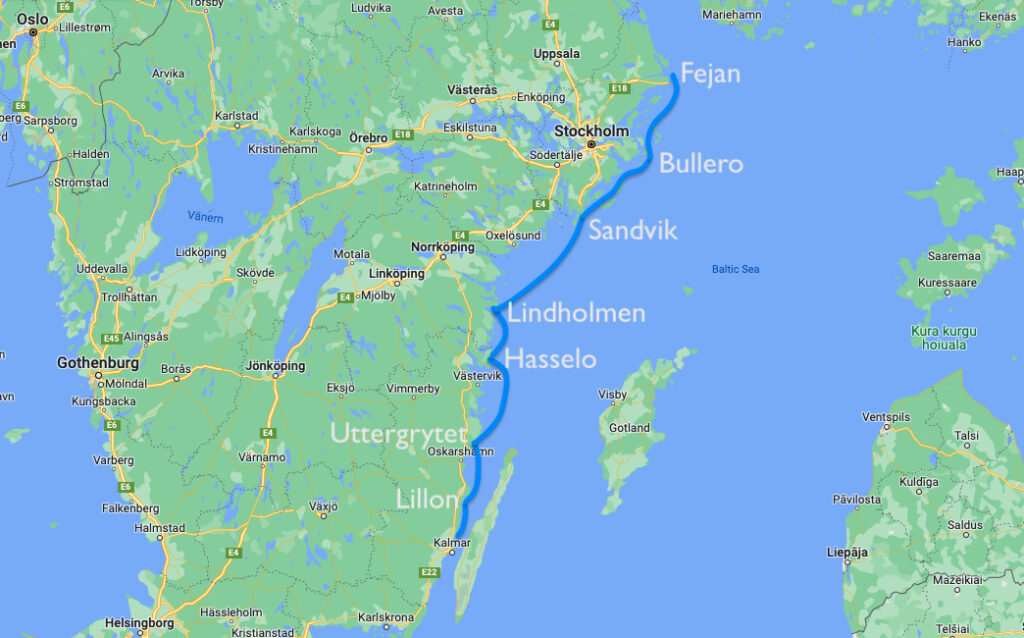
Our first stop and a welcome introduction to the stunning nature that is the coast of Sweden was the anchorage at Lillon. As we approached, the steady straight shoreline gave up its one dimensionality, and soon we had reduced our speed to such a slow pace that we were barely making a ripple on the water. Rocks up ahead and on both sides of us started to converge, a scene reminiscent of Ron Weasley’s fear of spiders emerging from the forest in Harry Potter’s Chamber of Secrets.
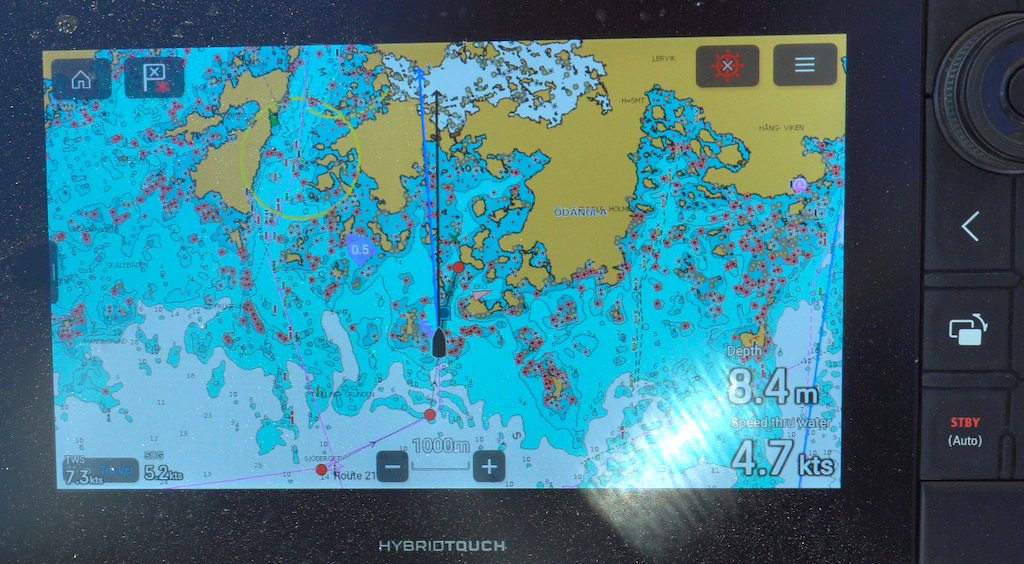
As we poked our way in, some rocks were visible ever so subtly above the surface while plenty of others were hiding just under the dark water as the depth sounder reading dropped to 0.4m under the keel. At the first spot that opened enough for us to swing at anchor, we dropped the hook, set it, and shut off the engine. Peace and tranquility reigned. Bird life was all around us. A swan and its baby cygnets paddled past, gulls dipped low to the water for a treat, a blue heron in its signature slow and steady flight passed overhead. It seemed perfectly plausible this scene before us had stood unchanged since before human existence, with its untarnished beauty.
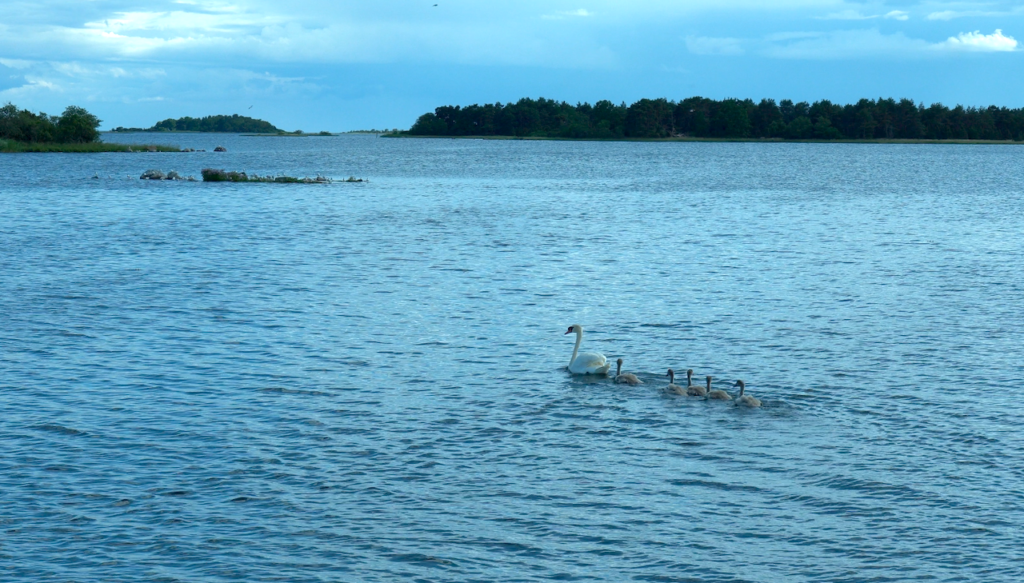
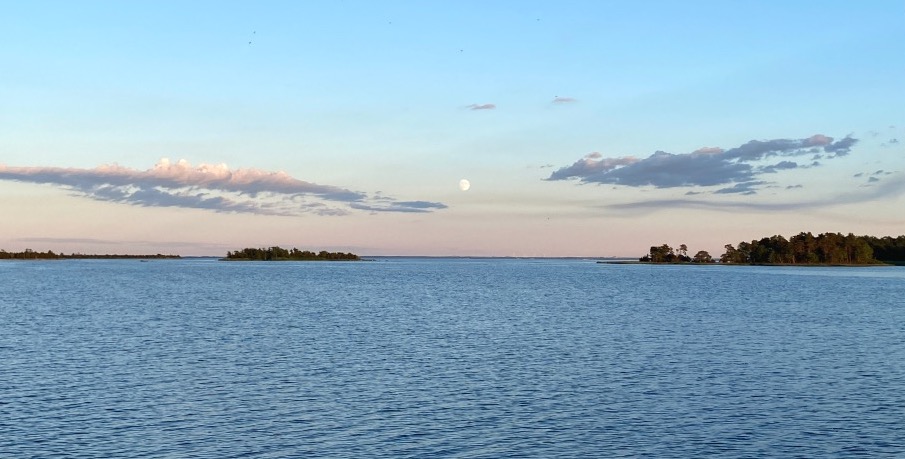
A nearly full moon rose in the east, competing for attention with a pink-hued horizon. We both sat in silent awe. It had taken so much work to get here, but like any period in one’s life when you sacrifice comfort in pursuit of a goal, the prize at the end feels all the more sweet.
Ironically, as we left Lillon in the morning, we discovered the smoke stacks of a large pulp mill that was hiding just beyond the tree line of our anchorage. I was so happy its presence didn’t jilt our communal moment last night with the natural world. At least the town, appropriately named ‘Monsteras’ for the size of the mill, had the modern day sense to install wind turbines throughout the area to make up for the mill’s energy consumption.
We pushed on northward to another curiously named anchorage, Uttergrytet, where the complexity of navigating around rocks rose up a level, much like the advancement of levels in a video game. We passed the beginner level yesterday. Today would be noticeably more challenging.
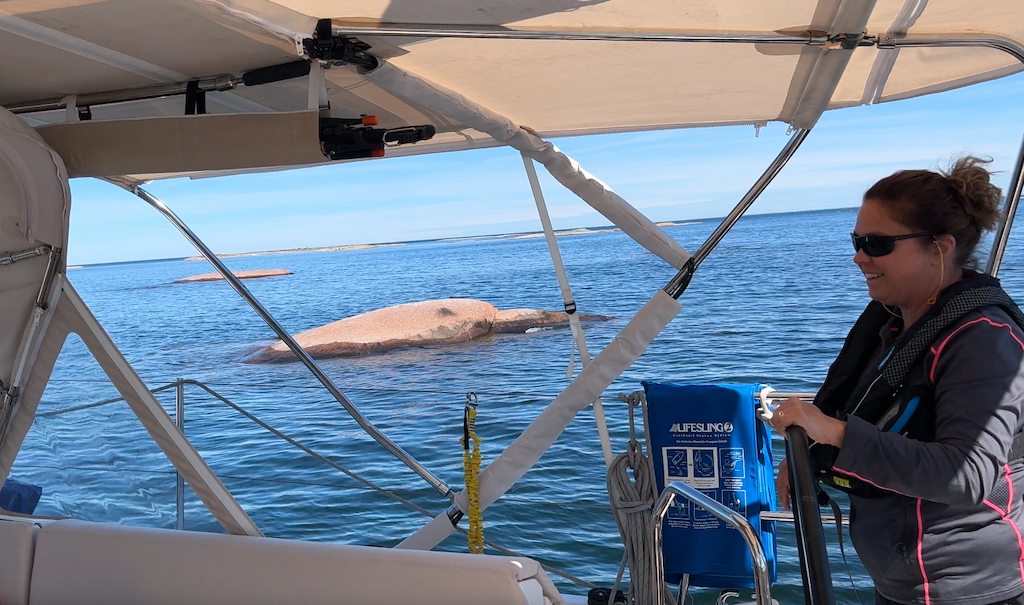
Round pink islets, likely smoothed over from the Ice Age, surfaced immediately to starboard and port, as we both focussed 100% on navigation, silencing depth alarms and waypoint arrival warnings, and reassuring whomever was at the helm that everything was going to be alright. As much as we tried, it felt a bit hollow, like trying to reassure a bride everything was going to be perfect as she walked down the aisle. Further disquieting the scene, we saw plenty of small runabouts, with their occupants splayed out on the sun-soaked rocks, but no sailboats our size. We took the hint and dropped the anchor at the first viable opening for swing room, backing down to run a stern line to a tree, a process so familiar from the Med that we could do it nearly in our sleep.
Launching the paddle boards, we witnessed plenty of fish underneath us, many that looked like cod. On the shore, remnants of irregular mining operations could be seen where squared off sections of red granite barely a person’s height above the water had been blasted away, leaving behind in the shallows the detritus of uneven blocks apparently not suitable for market. In the present post-industrial era, collections of adults gathered on shore near their moored powerboats, eating, drinking and celebrating the limited days of summer in an immensely respectable manner that was helping me craft a more complete image of the Swedish people. In so many other countries, including our own, significant noise and carelessness typically marked the experience around others in nature. Here, people’s moderated voices mirrored the gift of beauty surrounding us in all directions. A couple, landing their kayaks almost too far away to be seen, stepping out to arrange camp chairs and a picnic, barefoot and bare naked, seeming to typify the headspace for the rest of us.
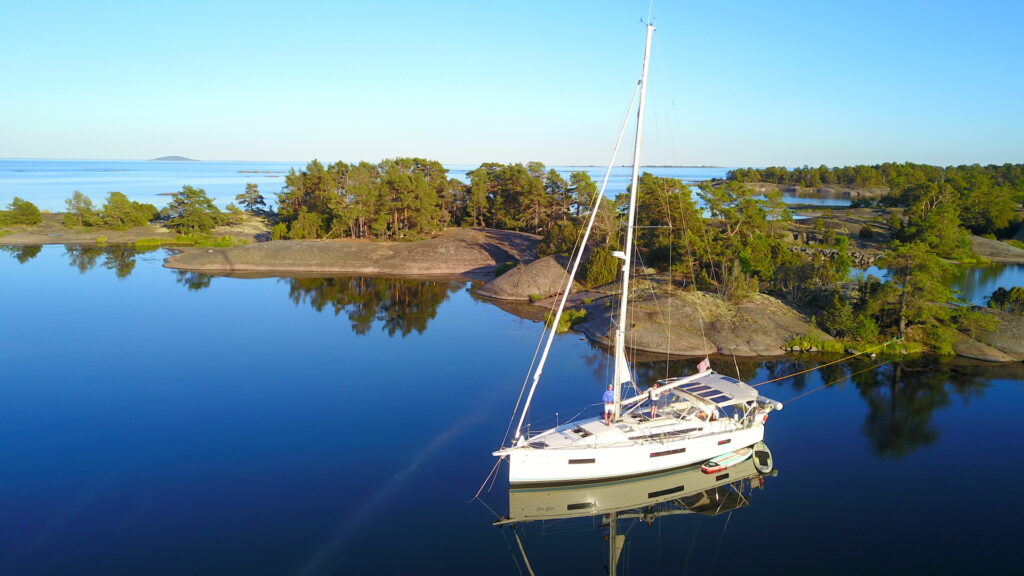
Innocent hedonism was cast aside at 3:30 am when we awoke suddenly to the anchor drag alarm. Youthful winds had pushed us closer to shore, but with still plenty of depth and enough light in the sky to make the distance seem less threatening. A bright orange horizon confused us – was this the remnants of last night’s sunset, or this morning’s sunrise? Regardless, the real alarm went off at 6am and we were motoring away by 6:15 am with full sun on our groggy faces. With this extended daylight, the best that you can get out of an overnight sleep is a long nap.
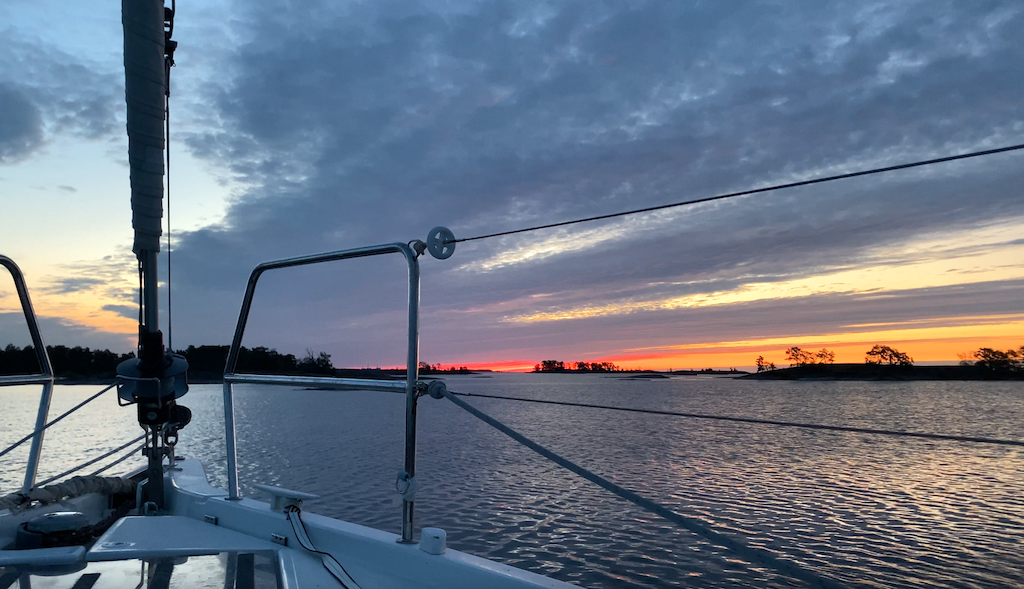
In the morning, with a continued lack of wind, we motored north to the island of Hasselo and discovered a far more civilized setting than our last few nights. Hasselo offered a campground, general store, cafe, and bike rentals. Getting ashore was the trick. A short T shaped dock extended from a beach surrounded by tall pines. The dock was full of powerboats and a few sailboats. As we edged closer, a spot appeared in between two small sailboats, but it appeared to require pushing these boats apart to fit the girth of Sea Rose. A side wind brought back fresh memories of the fuel dock at Kalmar, and two stern buoys, looking like they had been dragged off station by other boaters, were right in our path to the dock. We opted instead to anchor nearby, where we could have plenty of swing room. Sometimes the right decision stares you in the face and only stubborn habits blind you to the obvious. Soon, we were gleefully staring out from our anchored spot at the boats on the dock getting pummeled by the winds of a sudden summer squall.
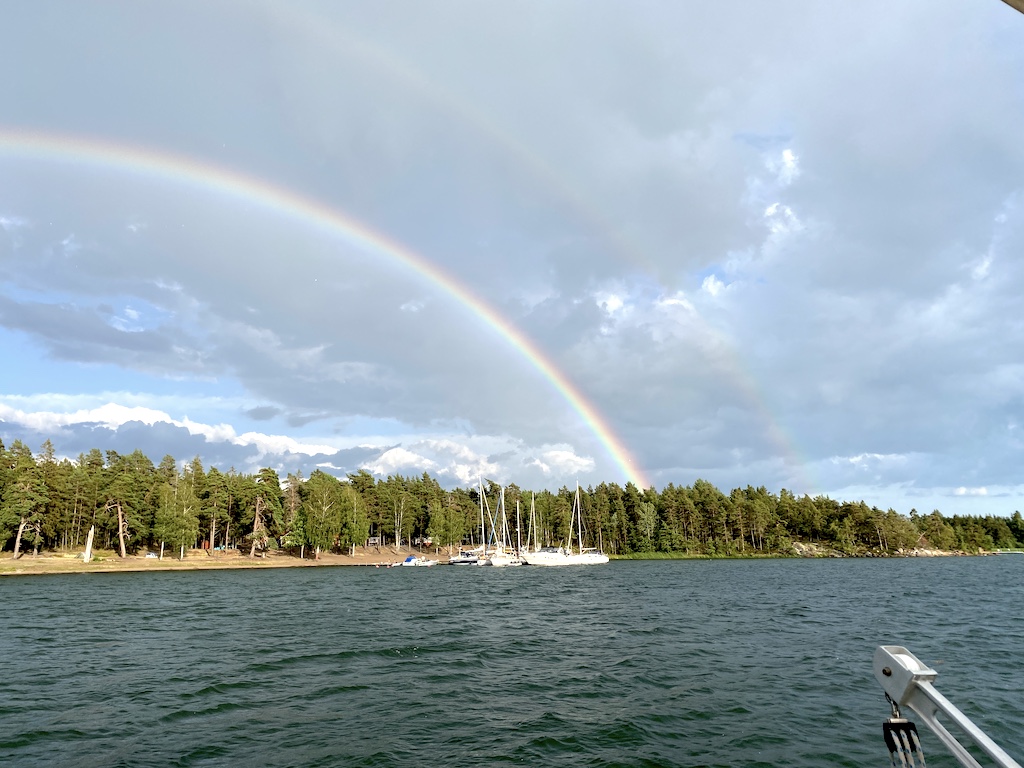


Then, in the distance, Karen spotted a small powerboat laying sideways against the granite rocks of the shoreline, rising up and down with each wave of the storm. With binoculars we could see that they were in trouble and needed help immediately. I hopped into the dinghy with some extra line and raced over to see what was happening. An old wooden cabin cruiser had lost their engine. Two men, one ashore on the rock, were trying to fend it off the sharp rocks. A women in the cockpit passed up a line to me so small it felt more appropriate for flying a kite. I handed them my dockline, and after discouraging them from just trying to hold on to it, we got it fastened to their bow cleat and I throttled up our little 15hp outboard. Soon, I had them upwind at a nearby dock, where they tied off bow and stern with their kite string. In addition to the two men and one woman, two little kids poked their heads out of the forward hatch. Shocked that they fit 5 people on this little lake cruiser, I quickly learned that I was the only human here with anxiety. They joked and bantered with each other, seeming to take the fact their boat narrowly avoided being an aquarium in stride. It was all no big deal to them. Another lesson in Swedish culture – hardy souls not prone to drama!
Finally, in the morning, with lingering traces of the previous day’s storm, we had enough wind to sail. Once clear of the close-in obstacles of this skargarten, we set sails on a brisk beam reach for a 20 mile jaunt back into the wilderness at Lindholmen. Here, at anchor, two blue herons flew away from their shoreside perch, reacting angrily to our arrival in their private Shangri la. “Get over it”, I thought to myself, “You are still the masters of this three dimensional world.” Choosing paddle boards once again to explore the surroundings, we came across three sailboats with their bows into the rocks. This is a common overnight tie up arrangement for Baltic sailors cognizant in the ways of the skargarten. Where we had become experts at going stern to the shore in the Med, here the universal strategy was bow in. It required a few accoutrements to avoid drama, which as we have established earlier, is not an endpoint the Swedes seek out. First, a stout stern anchor is required, and the finesse to know when to drop it so you have the proper scope out before you strike land. Second, you need a bow ladder. These come in all different configurations, but in the end allow you to graceful step off the bow onto the rocky shore, and trusting the amount of overhang your boat designer drew up, avoid hitting the hull on the rocks. It’s a potent cocktail of grace and skill (and maybe a little hubris) that we chose not to embide in. A healthy wake of a passing boat, not to mention sudden winds from a storm, could easily pit fiberglass with highly dense granite. But for the bold, it gave one an island to easily explore without a dinghy, and for these young lads and ladies, the real estate to practice jump rope to the tune of music, all at a respectably moderate noise level, while dinner was started on a portable barbecue. Sailing here for Swedes felt like a natural extension of car camping, with so many islands to choose from and no need to repeat any.
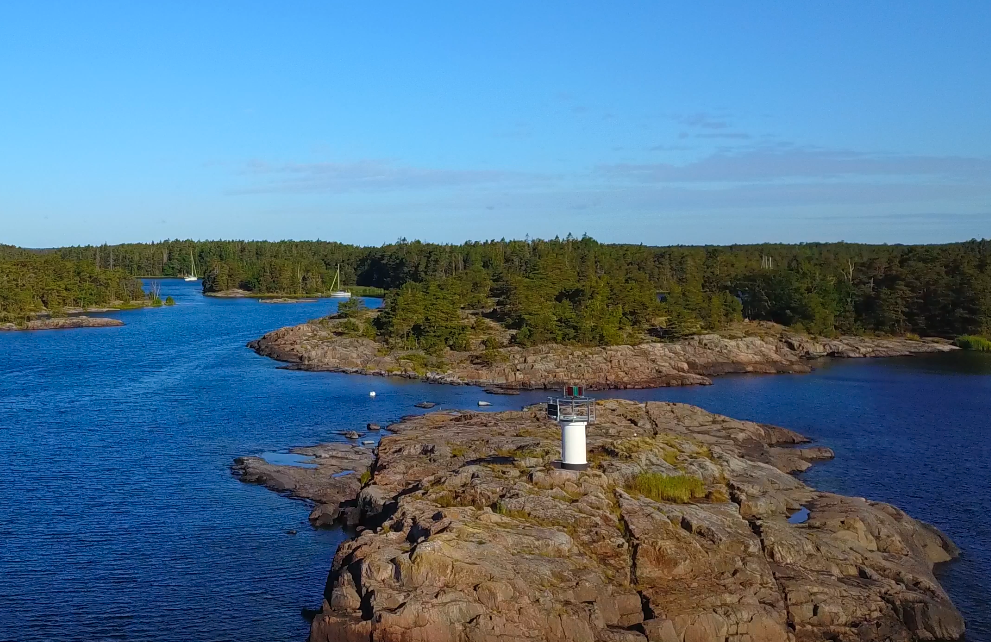
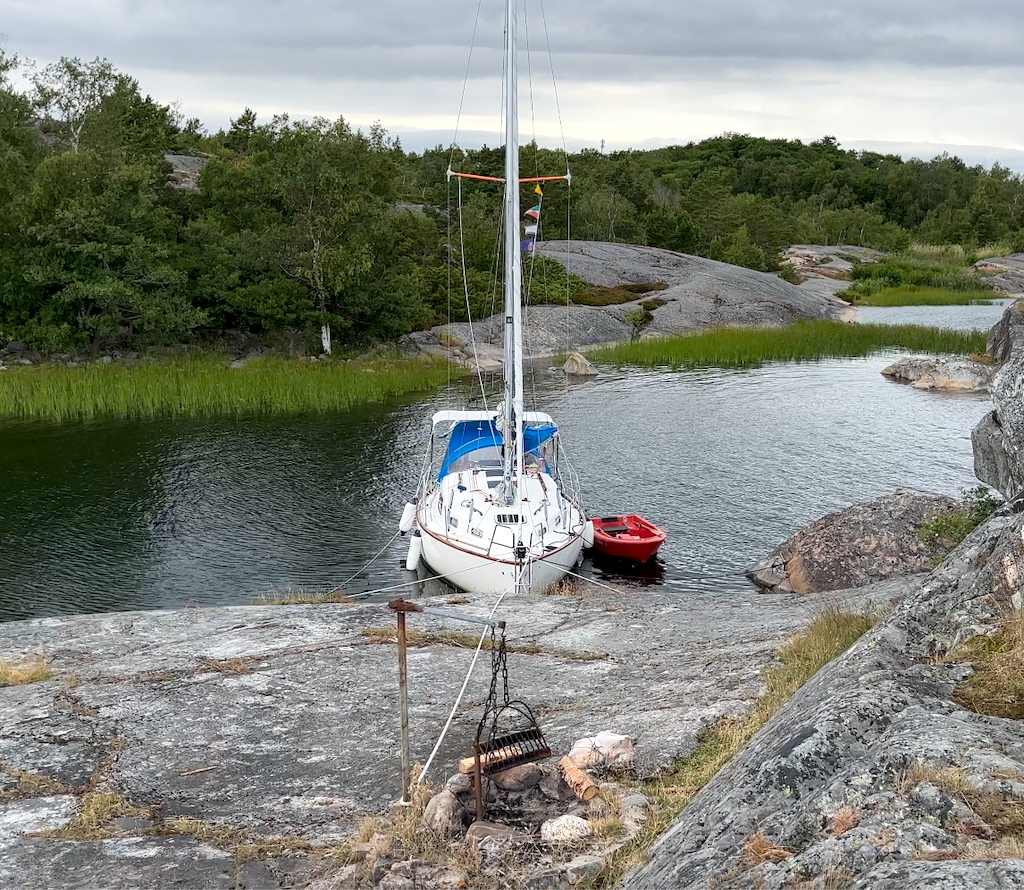
After an evening with our noses in the cruising guides, we decided to make a go at sailing into Finland. We were getting closer to the Stockholm skargarten, and a large archipelago stretching between Sweden and Finland would make the passage across the Baltic less risky. Like so much travel, the likelihood of making it back to the same place you’ve been to previously is rare, so it seemed to make sense to push for Finland now while we were in the neighborhood. With three long day hops, we could make it to Fejan, the logical departure point to cross over to Finland. Fortunately, we had the wind on our side as well. With 50 miles to go and a lot of open water on our first day, we sailed on a rolling and erratic beam reach in the kind of sloppy waves that accompany unsettled atmospheric conditions. Winds started pushing 30 knots as we reefed down our main and other boats passed us on their way south sailing under jib alone. Speed brings out the addictive side in all of us, like a friend at a bar pleading, ‘Come on, have just one more with me!” We couldn’t say no to the 8+ knot speed readings even as we hung on with too much sail area up.
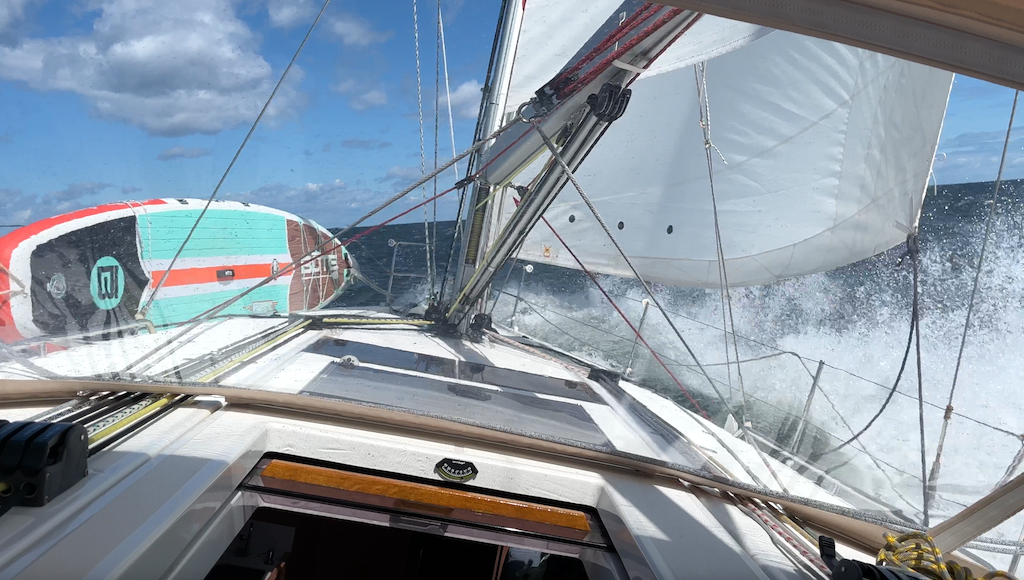
With so many islands along this coast, anchorage options are a dime-a-dozen, and we settled in for the night at Sandvik, all alone apart from a few signature red summer cottages with the distant sound of kids on summer holiday.
The navigational chart in this region identifies several routes through the island-strewn coastline, which cuts down tremendously on the work to lay out each day’s waypoints. You don’t want to sail for miles inside of a long island to find out it dead ends or is only passable for shallow draft sailboats. Each morning we would mark waypoints on the chart plotter and combine them, sometimes 30 or more, into the day’s route. This reduced the amount of scrolling and zooming we had to do while underway. If we hit each waypoint along the way, we’d be assured of staying in safe waters.
From Sandvik, we took an inside route between tall islands, at times sailing along briskly and at other times barely making headway; always with the promise of wind on the water up ahead. Along with the cycling of the wind, when the sun would go behind an island, it would feel like standing in a refrigerator with a fan blowing on you. When you were back in the sun, you were eagerly trying to strip off clothing. The power of the sun to drive comfort in these higher latitudes was a brand new experience for us.
After 40 miles of dancing with islands, we arrived at the out-lying anchorage named Bullero where a wood-fired sauna was available for public use. It was one thing to sit in an enclosed sauna in a city like Kalmar. But to experience such pleasure in a small oasis like this far from civilization, heated by wood, was not to be missed. What our guide book and our plethora of boating apps failed to state, though, was the fact that this sauna burned down the previous summer and had falled into the sea from its perch on the rocky shore. Charred wooden timbers could still be seen. Alas, a delightful walk circled the island, ending at a restored hunting lodge and one-time home of the famous Swede Bruno Liljefors, one of the most recognized wildlife painters of the 19th and early 20th century. In present times, a caretaker lived on the island, together with a rotating list of families staying at the makeshift hostel. There are plans to turn Bullero and several nearby islands into a national park in five years, a fitting tribute to an artist’s residence so connected to nature.
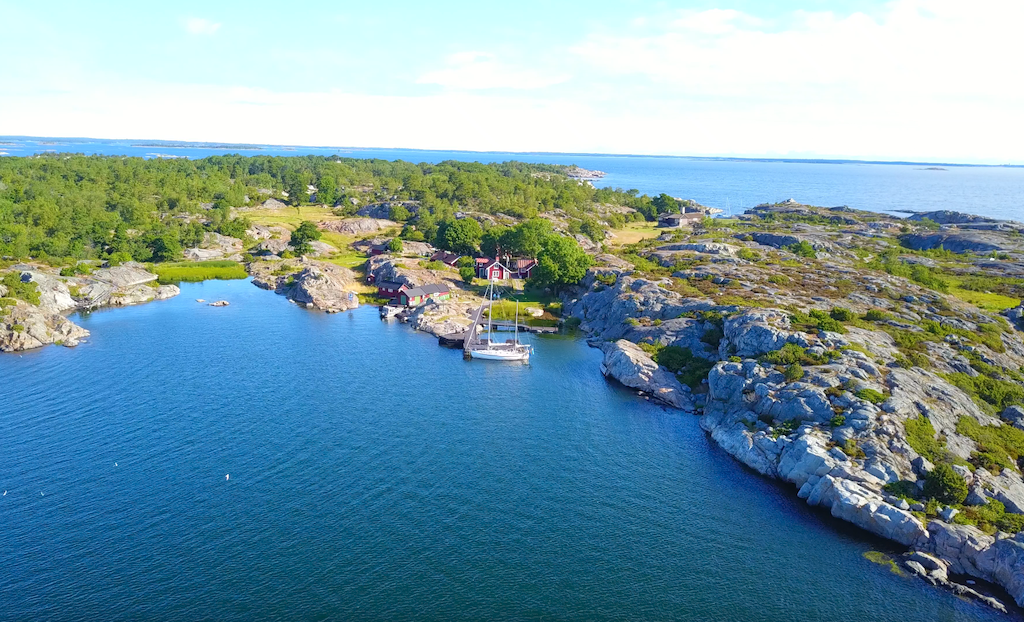
Our last push of 35 miles to Fejan was a test of wills, as the wind oscillated between a helpful 13-15 knots and then down to 5-7 knots from a completely different direction. I thought we would wear out the sheets with so much required trimming! As we approached the guest harbor at Fejan, with a purportedly very nice restaurant and a (hopefully not burned down) sauna, helpful hands from another boat came over to assist us. Every harbor is different and no matter how much you read ahead of time, it is hard to know what to expect when you arrive. Here, instead of the traditional stern buoys, they used laid lines, the slippery, slimy option used throughout the Med to connect your stern to a heavy sunken mooring off the dock. We were only the second boat on a completely wide open section of dock; however, other boats quickly arrived, and we paid the docking assistance forward by helping the new arrivals secure their lines. Within an hour, the entire harbor was full and boats were being turned away. Luck was on our side this time, and continued as we found an open late evening reservation at the restaurant. The host, when we delicately inquired about the sauna, confirmed it was included in the overnight dockage fee and cheekily informed us that if we had any questions on how to use the wood-fired heater, to just find a Finn, as they know everything there is to know about saunas! Lucky again for us, that’s exactly what we found! To our amazement, as we grabbed towels and followed a short grassy path to the sauna, a couple a little shy of our age was just coming out of the sauna to jump in the cool refreshing water. Not sure of the protocol in these sauna situations, we held back, but they eagerly waved us to come over and join in. I had read that Finnish people can be reserved, with some among them self-diagnosing it as social awkwardness, but Heli and Kalle were anything but. They were on the final week of a four week sail through Sweden before they returned to their home port in Helsinki. Their laughter was infectious and therapeutic. If others were to join us in the sauna, they would have thought we were lifelong friends, the conversation came so easily.
We carried on at the restaurant, and then back onboard Sea Rose for a nightcap, with more laughter and story telling until the wee hours.
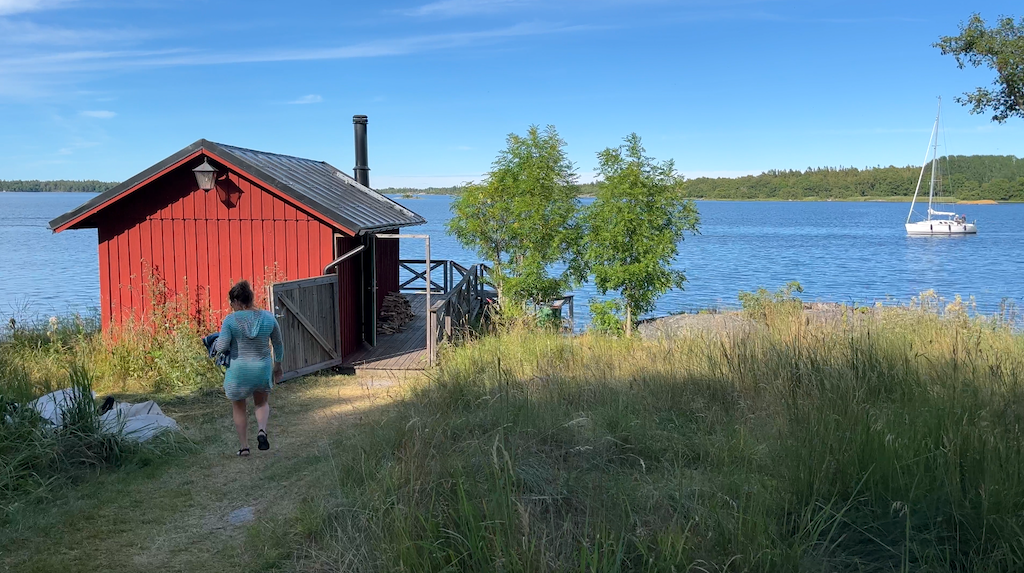
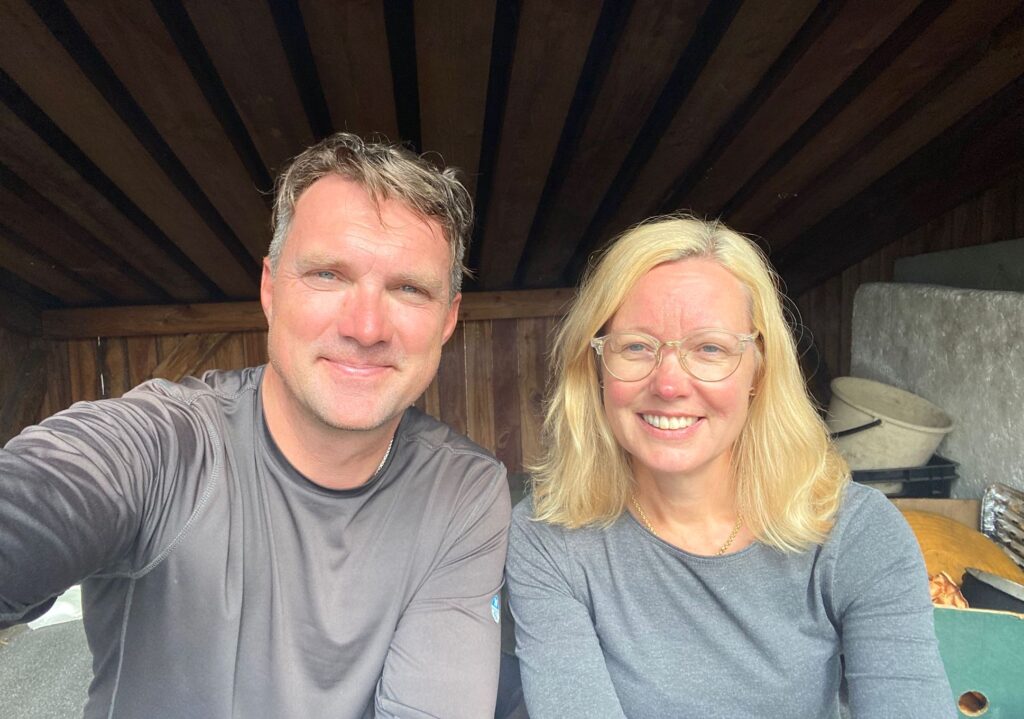
We were both headed across to Finland in the morning, which gave us an excuse to stay in touch as they filled our notebooks with must-see anchorages, restaurants and seaside villages. With no Finnish cruising guides currently in our possession, we were the spitting image of college freshmen at orientation week – equal measures confused and inquisitive. Our newfound friends from Finland had taught us the basics of wood-fired saunas, and so very much more. It had been a lot of long days to reach Fejan, but in the warm embrace of kind people – first Swedes, and now Finns – there was every reason to look forward to tomorrow.
Be sure to also checkout the video content on our LifeFourPointZero YouTube channel. We regularly post updates on our sailing adventures, as well as how to videos on boat repair, sailing techniques, and more!

